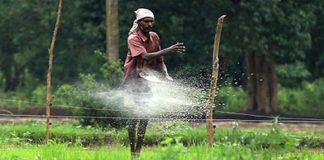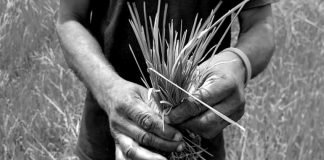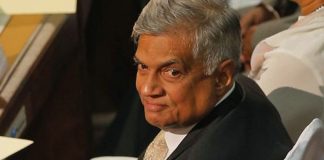Sri Lanka Port City set back by soft-peg collapse, unrest
ECONOMYNEXT – Sri Lanka’s China-backed Port City Project has faced a setback as due to the unstable situation in the country a top official said after two years of money printing to keep rates down triggered currency collapse and social unrest.
The Port City is a 1.4 billion US dollar sea reclamation project by unit China Communications Construction Company Limited, in partnership with the government of Sri Lanka which will sell a share of land to get revenue. Already 1.2 billion had been spent.
“We had a huge plan to aggressively market and sell Port City from this year but we have been challenged by the country situation,” Assistant Managing Director of CHEC Port City, Thulci Aluwihare told an online forum on May 28 by the Sri Lanka Economics Association.
Sri Lanka has seen progressive downgrades as money was printed to keep rates down and boost growth (stimulus or output gap targeting) under flexible inflation targeting triggering three currency crises in seven years as open market operations became increasingly aggressive.
In the latest crisis, the rupee collapsed to 366 to the US dollars from 200, in a botched float with a surrender requirement after a global pandemic which also delayed the project.
Monetary stability has still not been restored with money printing continuing and shortages seen in energy and medicines.
The Port City’s first large project, a 250,000 square metre office and retail development called the International Financial Centre are due to break ground in the third quarter of 2022, Aluwihare said.
The billion-dollar IFC’s first phase will see 500 million US dollars invested.
A Duty-free Store in association with two international operators, which is currently under construction, will be opened in the fourth quarter of 2022.
Utility connections to the periphery are to be completed by June 2023, he said.
Of the 100 hectares of land ready for development, 4.4 hectares by the Marina were sold for 200 million US dollars to predominantly local investors.
The Marina will be utilised for the development of an international luxury yacht marina and a five-star city hotel, which is also generating interest for residential development, he said.
Investors who get the land will then construct buildings, and permanent economic activities will then begin as businesses and residents occupy the buildings.
The project is slated to generate 143,400 direct jobs, and add 24 billion US dollars in economic value from reclamation and development. It is expected to generate 13 billion US dollars of gross domestic product a year when fully operational. (Colombo/June05/2022)
Sri Lanka agriculture goes to pot after soft-peg collapse
ECONOMYNEXT – Sri Lanka is urging citizens to grow vegetables in flower pots after the country’s economists mistargeted interest rates triggering a currency collapse and forex shortages continue amid money printing at higher interest rates.
After a partially failed main (Maha) cropping season and under-cultivation in the current Yala (minor) season due to fertilizer and fuel shortages, Sri Lanka is expecting record falls in food production.
Global commodity prices including foods and energy have risen in the so-called ‘Powell Bubble’ fired by US Federal Reserves, which also initially lied and blamed rising foods on ‘supply chain shortfalls’ but has since raised interest rates to stop money printing.
“If you have twenty flowerpots, and you grow food in at least ten of them, then we can get out of this crisis,” Agriculture Minister Mahinda Amaraweera told a reporter in Colombo.
“There are so many types of Yams that can be grown. If we do that we can successfully get out of this global crisis.”
Sri Lanka has imported more rice with crop shortfalls. Agriculture experts say about 5 months’ worth of rice (about a million metric tonnes) may need to be imported.
Minister Amaraweera says already about 338,000 Metric tonnes of rice have been imported and the government wants to import more rice before prices go up further.
Sri Lanka would need about 400 million US dollars to import a million tonnes (about two months’ worth of dollars coming through the Undiyal system). However, there are warnings that all food imports may be hit after open account imports were banned by the state.
After printing money to mis-target interest rates, Sri Lanka usually imposes various controls in cascading policy errors which worsens the fallout of central bank action.
After two years of money printing by the country’s Keynesian economists who favour an unstable peg (flexible exchange rate) with discretionary monetary policy (flexible inflation targeting) and output gap targeting (printing money to push up growth) inflation is soaring.
In May, has already hit 39 percent. Food prices have risen 57.4 percent in the 12-months leading up to May.
There have been calls to reform the central bank and hold it accountable so that it can no longer practice ‘flexible’ or discretionary policy.
Under the current law which binds the agency to economic and price stability, generating monetary stability and targeting output through ‘flexible policy’ is a violation of its basic goals.
However a draft law to legalize flexible policy and allow officials to escape accountability, and also give legal assistance is in existence, critics have said. (Colombo/June05/2022)
Yala harvest in crisis due to non-availability of fertilizer
SriLankan Airlines loses Rs170bn in 2021 amid soft-peg collapse, total losses...
ECONOMYNEXT – State-run SriLankan Airlines had lost 170 billion rupees in 2021 and its accumulated losses had risen to 542 billion rupees, a Finance Ministry report said despite the national career improving its performance in the last quarter.
SriLankan Airline’s revenue fell to 71 billion rupees in 2020 in the Coronavirus pandemic triggering a 45 billion rupee loss.
In 2021 revenues grew to 134.6 billion rupees as foreign travel was gradually relaxed.
But the airline had been hit by high finance costs and currency depreciation as the island’s soft-pegged central bank triggered the worst currency crises in its history.
In the year to March 2022 finance costs went up to 122.5 billion rupees from 35.6 billion rupees and unrealized forex losses were 47.7 billion rupees, up from 6.8 billion rupees a year earlier.
SriLanka’s intermediate regime central bank created the worst currency crisis in its history in 2022 after two years of money printing and a botched float with a surrender requirement.
The government has re-issued letters of comfort of 205.4 million US dollars and 27.6 billion rupees to state banks for loans given to SriLankan Airlines.
The airline had trade creditors of 183 billion rupees including 89 billion rupees owed to state-run Ceylon Petroleum Corporation.
SriLankan Airlines had interest bearing liabilities of 372 billion rupees, the report said.
“This scenario has had a significant impact to the banking sector and the CPC,” the Finance Ministry said.
“Furthermore, the capital erosion of Sri Lankan Airlines has been aggravated by the massive loss experienced in 2021/22, throwing further doubt on SLA’s going concern in light of the government’s fiscal restricted fiscal space and the financial environment of the state banking sector.”
“..[U]under the prevailing economic conditions, the Government is no longer in a position to finance SLA’s losses and therefore SLA requires an immediate transformation to clear up their liabilities through a proper business restructuring by selecting a suitable
business partner.
SriLankan Airlines has lost money since ex-President Mahinda Rajapaksa ousted Emirates Airlines as managing shareholder an re-nationalized the airline.
Amid food shortage fears, Sri Lanka president orders to cultivate in...
ECONOMYNEXT – Sri Lanka President Gotabaya Rajapaksa has instructed to identify all underutilized lands owned by plantation companies and prepare an expeditious programme to cultivate food crops, his media division said on Saturday as the crisis-hit island nation is facing a food shortage in the near future.
“Plantation companies own more than 9,000 hectares of uncultivated land. The President pointed out the need to identify suitable crops for cultivation in respective estates owned by 23 companies,” the President’s Media Division (PMD) said in a statement citing Rajapaksa made the remarks at a discussion held at the President’s House, o Friday (03).
The president’s instructions come as the island nation’s agricultural experts have warned of a possible shortage of rice and other essential foods possibly in September because of lower production due to the impacts of chemical fertilizer ban last year and inability to import amid dollar shortage.
Prime Minister Ranil Wickremesinghe has already warned of an acute food shortage by August and said the island nation would require $600 million to import fertilizer amid Sri Lanka’s near zero foreign currency reserves.
Crop scientists have warned that Sri Lanka could produce enough rice only for seven months of this year due to the fertilizer ban. Before the fertilizer ban, Sri Lanka had self sufficiency in rice production.
A Food Crisis? The Facts
21A : Party Leaders agree that it should avoid provisions calling...
Sri Lanka PM reveals plan to prevent tuk-tuk fuel shortage
ECONOMYNEXT- Prime Minister Ranil Wickremesinghe has said the government has planned to maintain supply of fuel for three wheelers in a manner that will not be create a shortage, his office said on Friday (03).
Sri Lanka has nearly more than 1 million three wheels and it has become a source of self employments for nearly 1 million people, official data show.
Many three wheel drivers lost their usual earnings while some lost their livelihoods due to fuel shortage and long queues for fuel amid the price sharply increased to record high.
Wickremesinghe had discussions regarding the supply maintenance of fuel with representatives of the Three Wheeler Associations on Thursday (02), his office said.
“The Prime Minister agreed to support the establishment of a three wheeler regulatory body,” his office said in a statement.
Sri Lanka needs around $500 million a month to import required fuel, while the country’s dollar shortage has forced the island nation to depend on an Indian credit line for fuel and essentials from March this year.
“Therefore, discussions were held at length on measures to be taken to protect the three wheeler industry in the face of the crisis facing the country in the future,” it said.
In addition to this discussion, Wickremesinghe had meeting with representatives of the Petrol Station Owners’ Association, in which the security of the petrol stations and the regularization of fuel supply was discussed.
Security of the petrol stations and the regularization of fuel supply have become priority after a mob torched a fuel station owner’s residence in Anuradhapura on May 21, using a petrol bomb.
(Colombo/June 03/2022)
Sri Lanka Prime Minister briefs FAO, UNDP on looming food shortage
ECONOMYNEXT – Sri Lankan Prime Minister Ranil Wickremesinghe on Friday (03) briefed the representatives of Food and Agriculture Organisation (FAO) and United Nations Development Program (UNDP) over possible food shortage and the plans to overcome the production gap, the prime minister’s office said.
The meetings come as the island nation’s agricultural experts have warned of a possible shortage of rice and other essential foods possibly in September because of lower production due to the impacts of chemical fertilizer ban last year and inability to import amid dollar shortage.
Wickremesinghe has already warned of an acute food shortage by August and said the island nation would require $600 million to import fertilizer amid Sri Lanka’s near zero foreign currency reserves. Crop scientists have warned that Sri Lanka could produce enough rice only for seven months of this year due to the fertilizer ban. Before the fertilizer ban, Sri Lanka had self sufficiency in rice production.
Wickremesinghe met Vimlendra Sharan, the Country Representative of the FAO and Malin Herwig, the Deputy Country Representative of UNDP on Friday.
“The Prime Minister explained that in view of the threat of a food shortage, a food security program was being compiled by the agriculture department officials. This program is due to be unveiled next month, with the UNDP expressing their support for the initiative,” Wickremesinghe’s office said in a statement.
“He (Wickremesinghe) stated that the biggest issue currently facing the agriculture sector is the fertiliser and fuel shortage. The Prime Minister also elaborated on the urban agriculture initiative that he had established to try and overcome a potential food shortage.”
Sri Lanka is unable to import fertilizer although President Gotabaya Rajapaksa has cancelled his detrimental fertilizer ban policy because it does not have dollars and sharp increase in fertilizer prices globally.
Sri Lanka produces no nitrogen fertilizer. Rajapaksa banned chemical fertilizer and requested farmers to go for only organic fertilizer. Paddy harvest has seen a decline of around 40 percent in the last two cultivation seasons, crop scientists have said.
The prime minister’s office said the UNDP explained that they were compiling an innovative farming assistance program which would help the farming community overcome the fertiliser shortage.
“The FAO also explained that donors had stepped forward to assist the country in the urban agriculture program, and was hopeful that a successful implementation would see more financial support provided,” it said in the statement.
“The FAO also stated they were drafting a food crisis response plan that can be enacted in Sri Lanka.”
“The Prime Minister explained that within 5-6 months the current agriculture shortages could be salvaged if swift action was taken to address the shortages faced by the farmers.” (Colombo/June 03/2022)
Power cuts dampen Sri Lanka rubber product exports despite higher global...
ECONOMYNEXT – Sri Lanka’s power disruption is slowing down the island nation’s rubber exports, despite there is an increased global demand for rubber-based products this year, Sri Lanka Association of Manufacturers and Exporters of Rubber Products (SLAMERP) said.
“Rubber industry’s order books are full and we being offered more orders,” Rohan Masakorala, the Secretary-General of SLAMERP told Economy Next.
“But the problem is we cant take because there’s not continuous power and energy.”
Export earnings from Rubber and Rubber finished products from January-April 2022 have edged up 1.3 percent to 337.6 million US dollars compared to 333.28 million dollars in the same period last year, Export Development Board (EDB) data showed.
Masakorala attributed the rise in demand was due to opening up of main markets in Europe after Covid-19 pandemic.
“After two years of slowdown in markets, people are demanding for more automobile while the covid infections in the key markets are still present. So we are seeing a demand for tyres as well as products like gloves,” he said.
EDB has said the demand for pneumatic & retreated rubber tyres & tubes had increased by 10.3 percent in the first four months, but the export of industrial and surgical gloves has decreased by 13.5 percent, as the industry is unable to absorb extra orders because the country grappling with its worst and unprecedented economic crisis in its history.
“Expansion is difficult when there are these uncertainties in the manufacturing sector,” Masakorala said.
Rubber is one of the top dollar earners of the country, generating 1 billion dollars for the year 2021, the highest in three years. The industry saw 33.6 percent jump in export earnings last year, the central bank data show.
The raw rubber needs a lot of energy to make value added products at high heating temperatures.
However, Sri Lanka’s extended power cuts since February 22 has dampened the growth of the industry as the island nation is still depending on Indian credit lines to import fuel for power generation due to severe dollar shortage.
“We are unable to do more business due to the current situation. The opportunity cost is the 20-30% of extra dollars we would have earned compared to last year,” the SLAMERP director general said.
“We could easily earn few more millions provided we are allowed to expand and invest to the extra demand.”
Other Sri Lankan export manufacturers are complaining that their orders are being cancelled due to fears of delivery due to the ongoing crisis. (Colombo/June02/2022)



